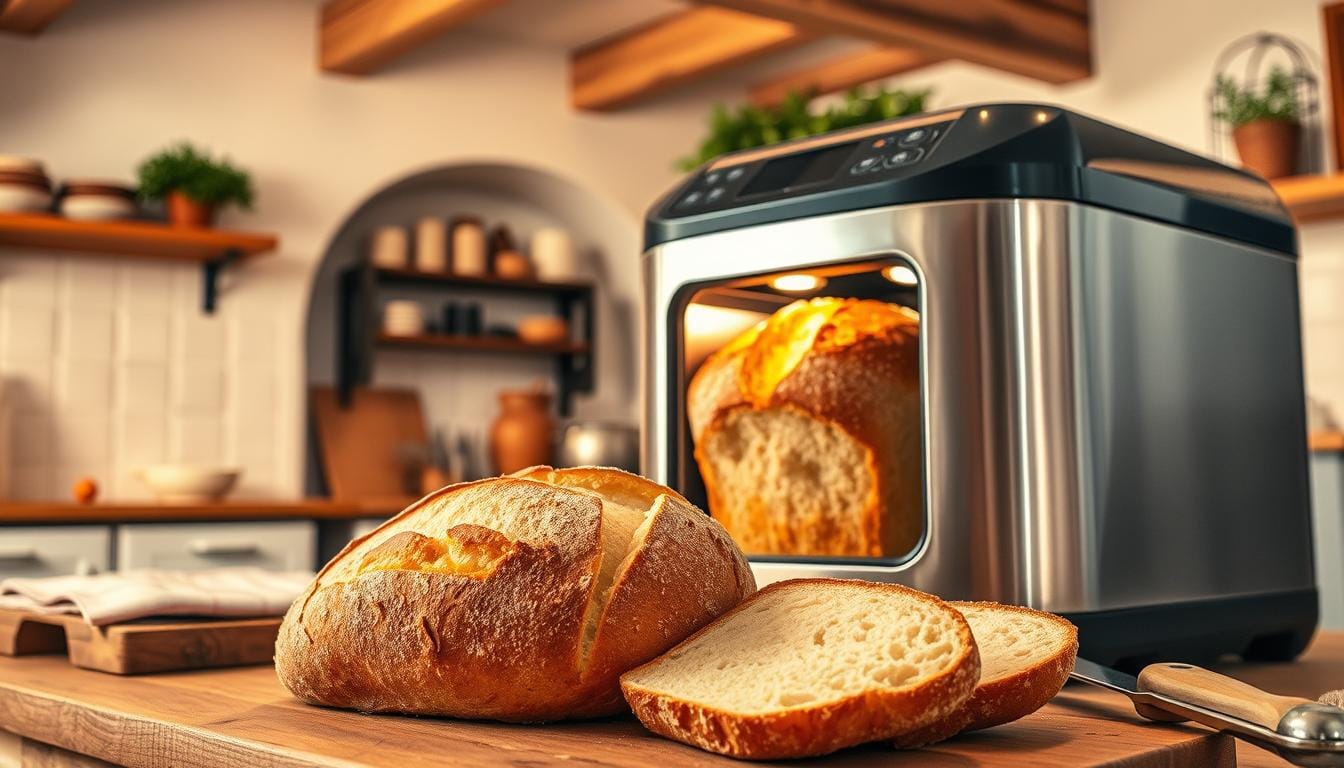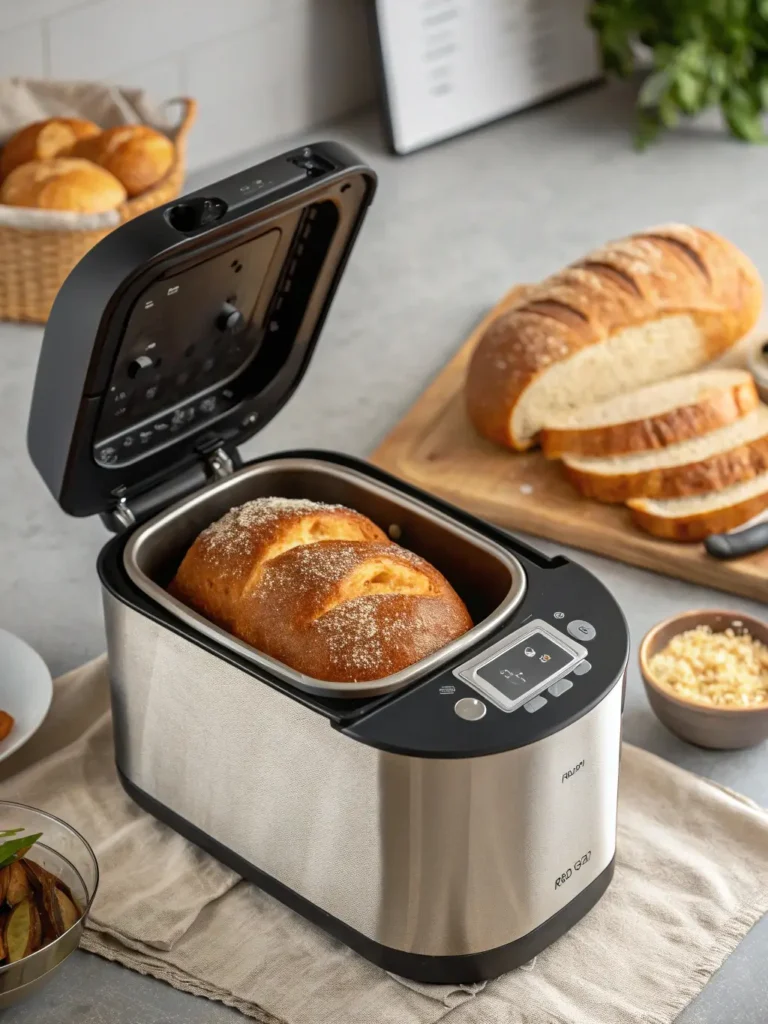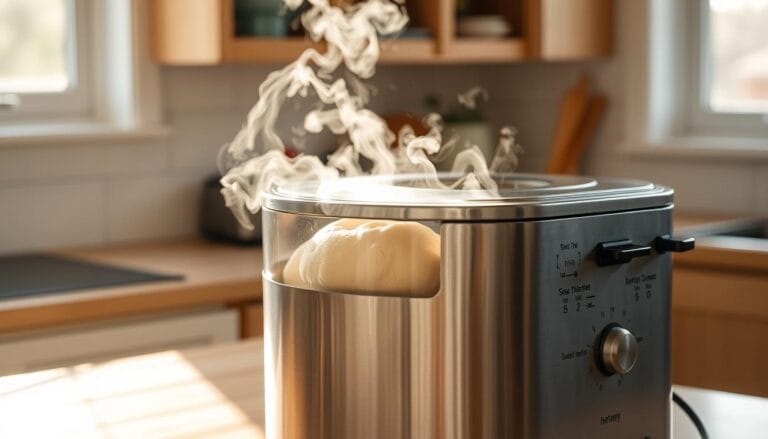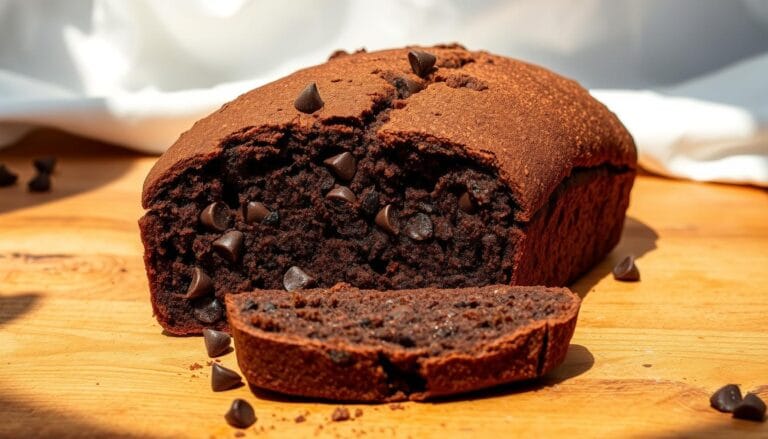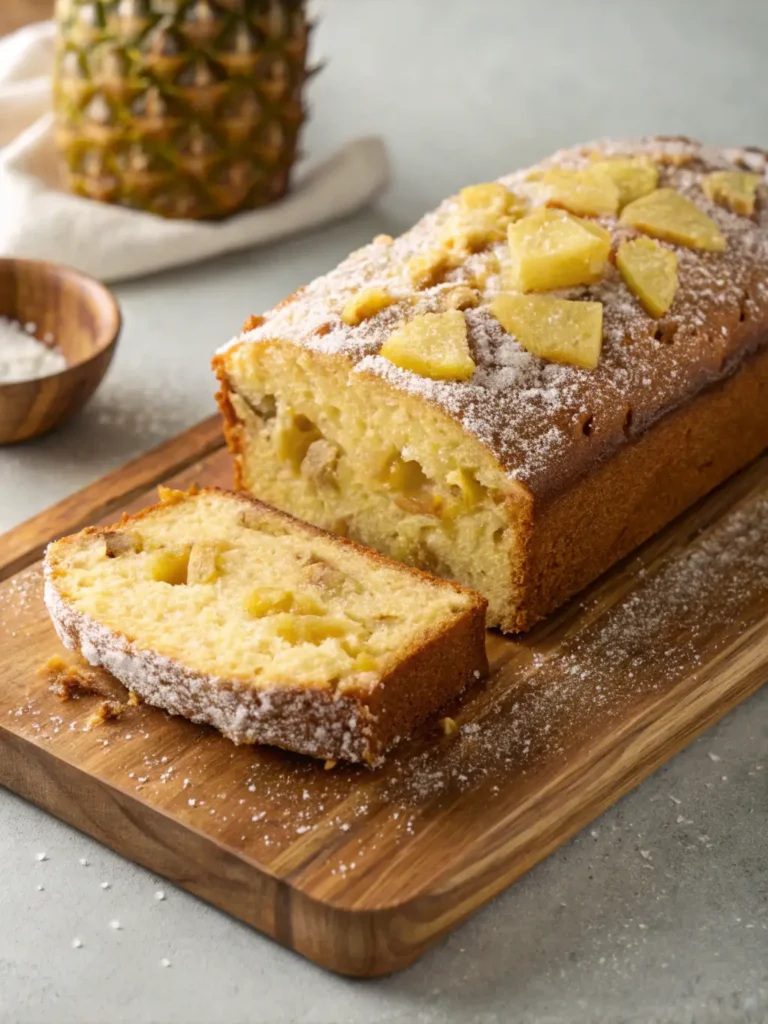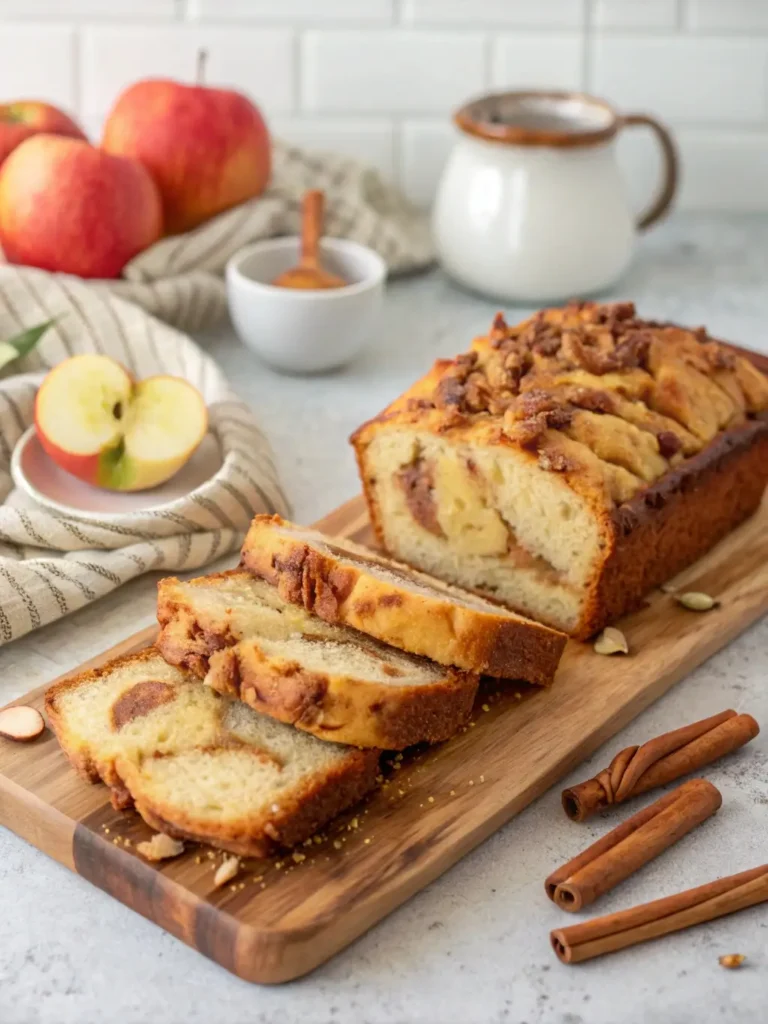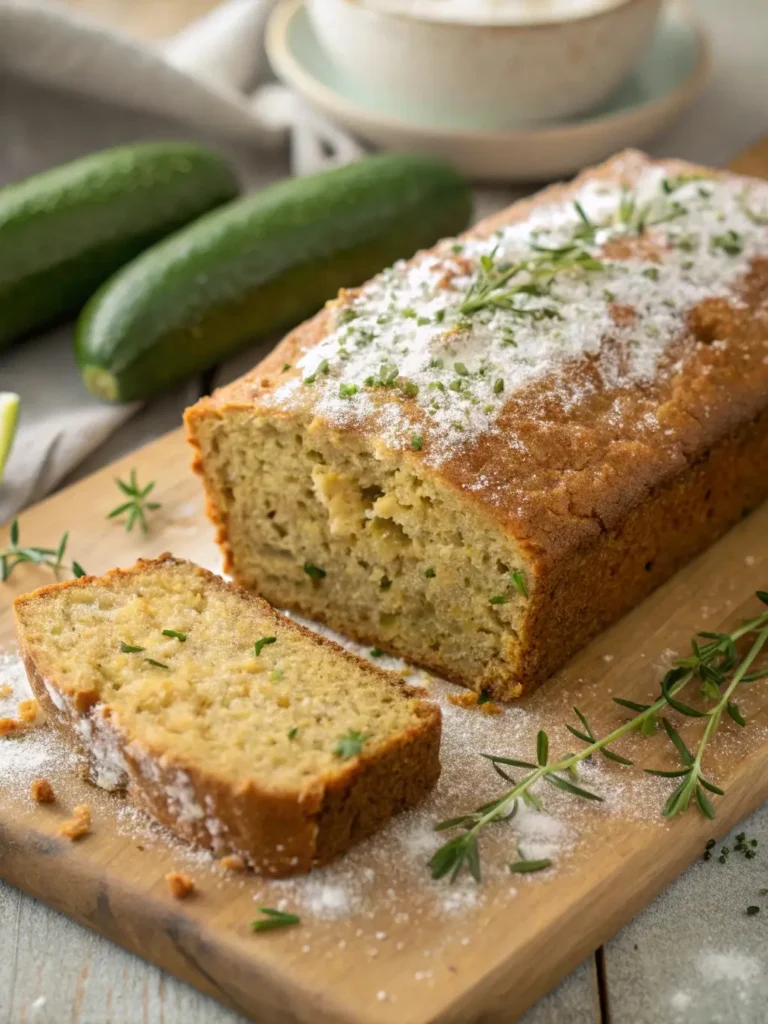How to Make Authentic French Bread in Your Bread Machine
The smell of fresh bread can make your kitchen feel like Paris. I fell in love with making bread machine French bread, just like the ones from bakeries. My first try wasn’t great, but I kept trying. Soon, I learned how to make homemade bread that warms your home.
Bread maker recipes have changed home baking. They make it easy to make French bread at home. This guide will help you make the perfect loaf in your bread machine, whether you’re new or experienced.
Table of Contents
Key Takeaways
- Bread machines simplify the French bread-making process
- Authentic French bread requires specific ingredients and techniques
- Combining machine mixing with traditional baking methods yields best results
- Proper technique is crucial for achieving a crispy crust and soft interior
- Homemade bread offers superior flavor and freshness compared to store-bought options
Understanding French Bread Basics for Bread Machines
Starting with bread machines can seem daunting, but they’ve made home baking easier. To make perfect crusty French bread, learn about bread-making tech and old-school methods.
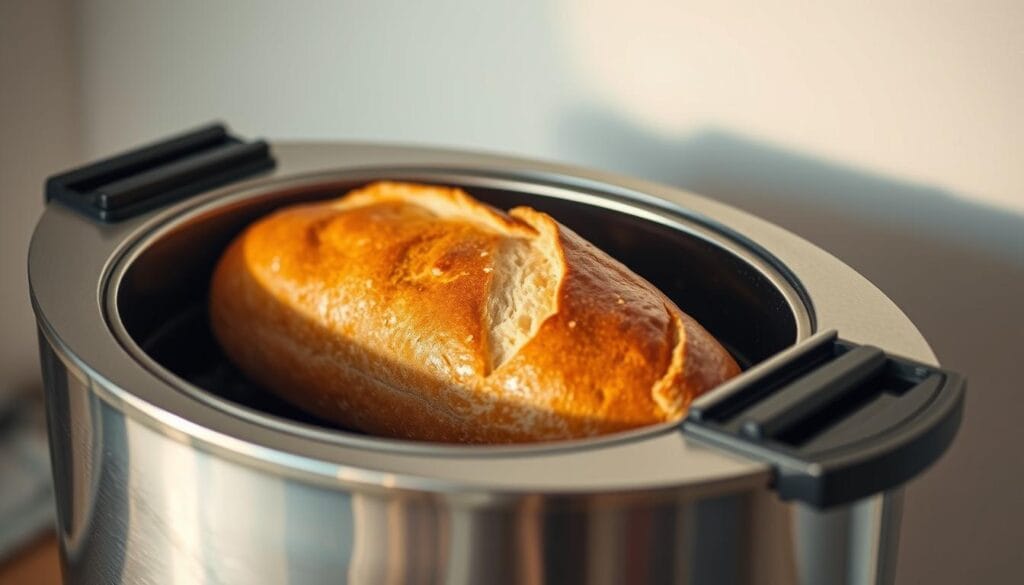
Bread machines make authentic no-knead bread easy. They mix modern tech with traditional baking. This combo keeps the bread’s classic taste and texture.
Difference Between Traditional and Machine-Made French Bread
Old-school French bread needs lots of hand-kneading and special skills. Machines do the hard work by:
- Automating mixing and kneading
- Controlling precise temperature
- Ensuring consistent dough texture
- Reducing manual labor
Benefits of Using a Bread Machine for French Bread
Using a bread machine for French bread has many perks:
| Benefit | Description |
|---|---|
| Consistent Results | Precise mixing and kneading every time |
| Time Efficiency | Reduced hands-on preparation time |
| Temperature Control | Optimal environment for dough development |
Key Characteristics of Authentic French Bread
Real French bread has certain traits:
- Crispy exterior with a golden-brown crust
- Soft, chewy interior with large air pockets
- Distinct wheat flavor
- Light and airy texture
Knowing these basics will help you make tasty artisan bread at home. It’ll be as good as what you buy from a bakery.
Essential Ingredients for Perfect Bread Machine French Bread
Making authentic French bread in your bread machine begins with the right ingredients. The key is high-quality bread flour. It provides the protein needed for perfect gluten development.
To make French bread, focus on a few important ingredients:
- Bread flour: The main ingredient that gives your bread structure
- Active dry yeast: Essential for bread proofing and rising
- Water: Hydrates the flour and activates the yeast
- Salt: Adds flavor and controls yeast growth
Knowing the role of each ingredient is key for success. Bread flour’s high protein content creates French bread’s chewy texture. The yeast you choose is crucial for flavor and texture.
| Ingredient | Purpose | Recommended Quantity |
|---|---|---|
| Bread Flour | Provides structure and protein | 3-4 cups |
| Active Dry Yeast | Enables rising and fermentation | 2-1/4 teaspoons |
| Water | Hydrates ingredients | 1-1/4 cups |
| Salt | Enhances flavor | 1-1/2 teaspoons |
Pro tip: Always add ingredients to your bread machine in the order recommended by the manufacturer. This ensures proper mixing and optimal bread proofing results.
Choosing the Right Bread Machine Settings
Mastering your bread machine settings is key to making delicious French bread. The right settings can turn your bread into something amazing. Your bread machine has many cycles and options that greatly affect the outcome.
Choosing the right settings means knowing your bread maker’s abilities. Different recipes, like French bread, need special care.
Understanding Dough Cycle vs. Full Bake Cycle
For French bread, the dough cycle is best. It lets you:
- Mix and knead the dough automatically
- Control the first and second rise
- Shape and bake the bread yourself
Temperature and Time Control Tips
Getting the temperature right is crucial for French bread. Here are some tips:
- Use warm ingredients (around 110°F)
- Choose the medium crust setting
- Keep the temperature steady
Common Setting Mistakes to Avoid
Stay away from these mistakes to avoid bad results:
- Don’t overmix the dough
- Get the liquid-to-flour ratio right
- Consider the room temperature
Pro tip: Always check your bread machine’s manual for exact settings and tips.
Step-by-Step Mixing and Kneading Process
Making homemade bread is all about the mixing and kneading. No-knead bread has made home baking easier. Now, you can make delicious French bread with little effort.
- Measure ingredients precisely
- Add liquid ingredients first
- Layer dry ingredients carefully
- Create a small well for yeast
The bread machine does most of the work. But, check the dough’s consistency during mixing. Look for these signs:
- Smooth texture means it’s well-hydrated
- Dough should form a cohesive ball
- It should be slightly tacky but not sticky
Gluten development is key for the perfect French bread texture. The kneading cycle in your bread machine stretches and develops the dough. This creates the bread’s characteristic structure.
| Mixing Stage | Key Observation | Ideal Outcome |
|---|---|---|
| Initial Mixing | Ingredient Integration | Uniform Moisture |
| Kneading | Gluten Development | Elastic Dough |
| Final Mix | Dough Consistency | Smooth Ball Formation |
Pro tip: If the dough is too dry, add water slowly. For wet dough, add flour a little at a time. This will help you get the right consistency.
Mastering the Bread Machine French Bread Dough
Creating the perfect homemade bread is all about understanding dough preparation. Your bread machine can help make amazing French bread if you know how to handle the dough. This includes managing its consistency and development.
Working with bread flour is key to getting the right dough texture for French bread. The dough should have certain qualities that show it’s ready for the next steps in bread proofing.
Proper Dough Consistency Guide
Your bread dough should have these important traits:
- Smooth and elastic texture
- Slightly tacky but not sticky surface
- Forms a clean ball that pulls away from machine walls
Troubleshooting Dough Problems
Simple fixes can solve common dough issues:
- Too dry: Add water one teaspoon at a time
- Too wet: Sprinkle bread flour gradually
- Adjust ingredient measurements for consistent results
Visual Cues for Perfect Dough
Look for these signs of well-developed dough:
- Smooth, shiny surface
- Elastic when stretched
- Passes the “two-finger test” – indentations slowly spring back
Mastering these techniques will make your homemade bread truly special. You’ll feel confident in every loaf you make.
Shaping and Scoring Techniques for French Bread
Turning your bread machine dough into real baguette bread needs careful shaping and scoring. This process makes simple ingredients into a stunning artisan bread. It looks and tastes like it’s from a French bakery.
- Take the dough out of your bread machine after the dough cycle
- Gently flatten the dough on a lightly floured surface
- Shape the dough into a long oval or traditional baguette form
- Create surface tension by carefully stretching and tucking the dough
Scoring is an art that makes professional bakery bread stand out. Use a sharp lame or razor blade to make diagonal slashes across the top of your loaf. These cuts do two important things:
- They let the bread expand during baking
- They create the signature crusty french bread look
Experts say to make 3-4 diagonal cuts about 1/4 inch deep. Hold the blade at a 45-degree angle for the best look. With practice, you’ll get good at making beautiful artisan bread that’s just like the pros.
Achieving the Perfect Crust and Texture
To make authentic crusty French bread, you need to learn a few key techniques. These techniques turn your bread maker recipes into artisan-quality loaves. The secret is in how heat, moisture, and timing work together.
Creating the perfect crust involves several important steps. These steps make your bread go from ordinary to extraordinary:
Creating Steam for Crusty Results
Steam is key for a beautiful crust on your artisan bread. Professional bakers use different ways to add moisture during baking:
- Place a shallow pan of water on the bottom rack of your oven
- Spray water directly onto the bread before baking
- Use a spray bottle to create a light mist inside the oven
Temperature Control Methods
Getting the temperature just right is crucial for that crusty French bread texture. Start with a high initial temperature to create rapid expansion and crust formation:
- Preheat your oven to 450°F (230°C)
- Reduce temperature to 375°F (190°C) after 10 minutes
- Bake until the crust turns golden brown
Timing Your Bake Perfectly
The final moments of baking are crucial for your crusty French bread. Visual cues are your best friend. Look for a deep golden-brown color and listen for a hollow sound when tapping the bottom of the loaf. An instant-read thermometer should register between 190-210°F (88-99°C) for perfectly baked bread.
Remember, making perfect crusty French bread takes practice. Each loaf brings you closer to mastering the art of artisan bread making in your own kitchen.
Storage and Serving Suggestions
Your freshly baked bread machine french bread needs special care. This keeps its texture and flavor just right. Storing it properly ensures you enjoy it at its best, whether now or later.
Short-Term Storage Methods
For the best freshness, try these storage tips:
- Use a bread box with ventilation to prevent moisture buildup
- Wrap in a clean cotton cloth or paper bag
- Keep at room temperature for up to 2 days
Freezing Your French Bread
Freezing is great for keeping your bread fresh longer. Here’s how to do it right:
- Cool bread completely before freezing
- Wrap tightly in plastic wrap or aluminum foil
- Place in a freezer-safe bag
- Freeze for up to 3 months
To enjoy your frozen bread, thaw it at room temperature. Then, warm it briefly in the oven to get that crispy crust back.
Serving Suggestions
| Serving Style | Recommended Pairings |
|---|---|
| Breakfast | Butter, jam, or fresh cheese |
| Appetizer | Olive oil, balsamic vinegar |
| Dinner | Soup, salad, or charcuterie board |
Pro tip: Slightly toast day-old bread to revive its texture and bring back that fresh-baked taste!
Advanced Tips for Artisanal Results
To make your crusty french bread truly professional, you need to master advanced techniques. These techniques turn simple baking into an art form. They bring out incredible depth of flavor and texture.
Here are some advanced strategies to improve your artisan bread skills:
- Use a baking stone or cast-iron Dutch oven to create professional-grade crust
- Implement extended fermentation methods to develop complex flavor profiles
- Experiment with preferment techniques like poolish to enhance bread structure
- Practice precise shaping techniques for visually stunning loaves
Bread proofing becomes magical when you understand the right temperature and time. A slow, cool fermentation lets natural enzymes break down flour proteins. This makes the bread more digestible and flavorful. Professional bakers say patience is the secret to truly exceptional artisan bread.
By investing in a few key tools and techniques, your crusty french bread can match bakery quality. A digital kitchen scale, precise temperature control, and knowing dough hydration will make a big difference. Your bread will have more complexity and texture.
Professional bread makers suggest keeping the proofing area at a consistent temperature. They also recommend handling the dough as little as possible. This helps keep the delicate gas bubbles that give artisan bread its unique crumb structure.
Alternative Methods and Variations
Trying new ways to make homemade bread can really boost your baking skills. French bread is super versatile. You can mix and match ingredients and techniques to match your taste and dietary needs.
Working with bread flour opens up a world of possibilities. Let’s explore some creative twists to inspire your baking.
Whole Wheat French Bread Version
Making whole wheat French bread needs careful mixing. Here are some tips for a tasty whole grain loaf:
- Replace 50% of white bread flour with whole wheat flour
- Add vital wheat gluten to improve texture
- Increase liquid content slightly to compensate for whole wheat absorption
Mini Loaf Adaptations
Mini loaves are great for personal servings or small gatherings. Your bread maker can handle these small treats:
- Divide dough into smaller portions before final rise
- Adjust baking time for smaller loaves
- Use shorter baking cycles to prevent overcooking
Specialty Flour Options
Trying different flours can give your bread unique flavors. Here are some specialty options:
- Spelt flour: Adds nutty flavor and improved digestibility
- Rye flour: Provides dense texture and distinctive taste
- Semolina flour: Introduces golden color and subtle sweetness
Remember, each flour type needs slight changes in how you mix and hydrate. Dive into the fun of making your own French bread variation!
Conclusion
Your journey to making homemade bread is now complete. You’ve learned how to make bread machine French bread. This skill turns simple baking into a true artisan experience.
Each loaf is a mix of skill and passion. It brings the taste of a professional bakery into your home.
The bread machine makes creating perfect French bread easy. You can try different flours and settings. This lets you add your own special touch to each loaf.
Remember, making great bread takes time and practice. Be patient and always ready to learn from each try.
As you keep learning about homemade bread, enjoy the fun of making something special. Your bread machine is a tool for creativity. Start with what you’ve learned and don’t be afraid to try new things.
Now, your bread-making journey is just starting. Keep trying new things, stay curious, and enjoy making bread. Your creations will impress everyone.
FAQ
Can I make French bread entirely in my bread machine?
You can use the full bake cycle in your bread machine. But, most people suggest using the dough cycle first. Then, bake it in a traditional oven. This way, you get a crispier crust and a more authentic French bread texture.
What type of flour works best for French bread?
Bread flour is the best choice for French bread. It has more protein, which makes the bread chewy and structured. All-purpose flour works too, but bread flour gives better results.
How do I get a crispy crust when using a bread machine?
For a crispy crust, start with the dough cycle in your bread machine. Then, take out the dough and bake it in a hot oven with steam. You can make steam by putting hot water in the oven or spraying water into it at the start of baking.
How long can I store homemade French bread?
Enjoy your French bread within 1-2 days for the best taste. Keep it in a paper bag at room temperature to stay crispy. If you need to store it longer, freeze it for up to 3 months. Wrap it tightly in plastic wrap and then foil.
Can I make whole wheat French bread in a bread machine?
Yes, you can make whole wheat French bread. Just replace some white flour with whole wheat flour. Start with 25-30% whole wheat and adjust the liquid as needed.
Why is my bread machine French bread dense or heavy?
Dense bread can come from old yeast, too much flour, not enough rising time, or cold ingredients. Make sure your yeast is fresh, measure ingredients right, and let the dough rise fully.
Do I need special equipment to make French bread?
You don’t need special equipment, but a few tools can help. A baking stone, a lame or sharp knife, and a spray bottle for steam are useful. But, you can still make great French bread with basic tools.
How can I tell when my French bread is fully baked?
Check the internal temperature with an instant-read thermometer. It should be around 190-200°F (88-93°C). Or, tap the bottom of the bread. It should sound hollow when it’s done.

